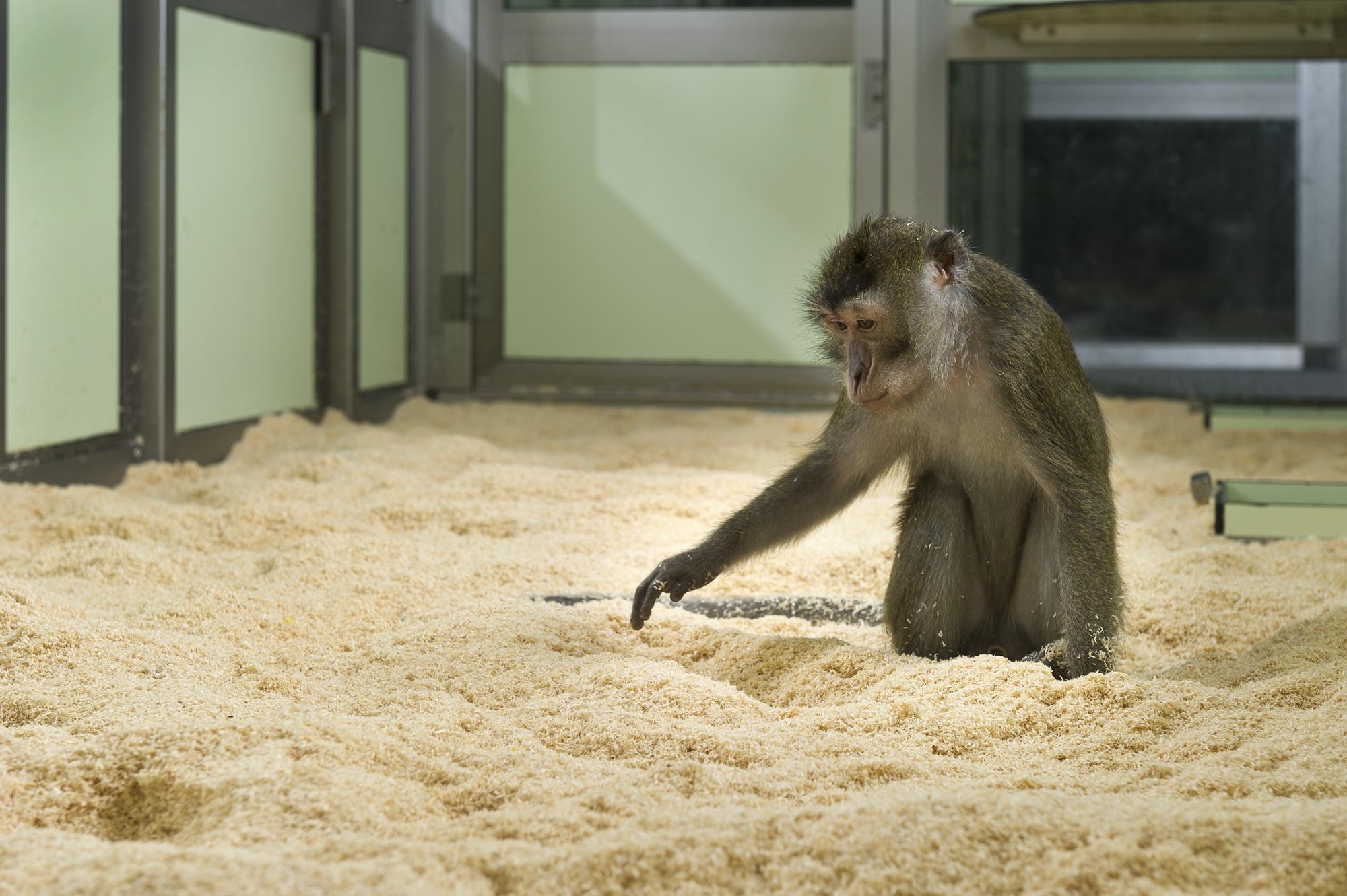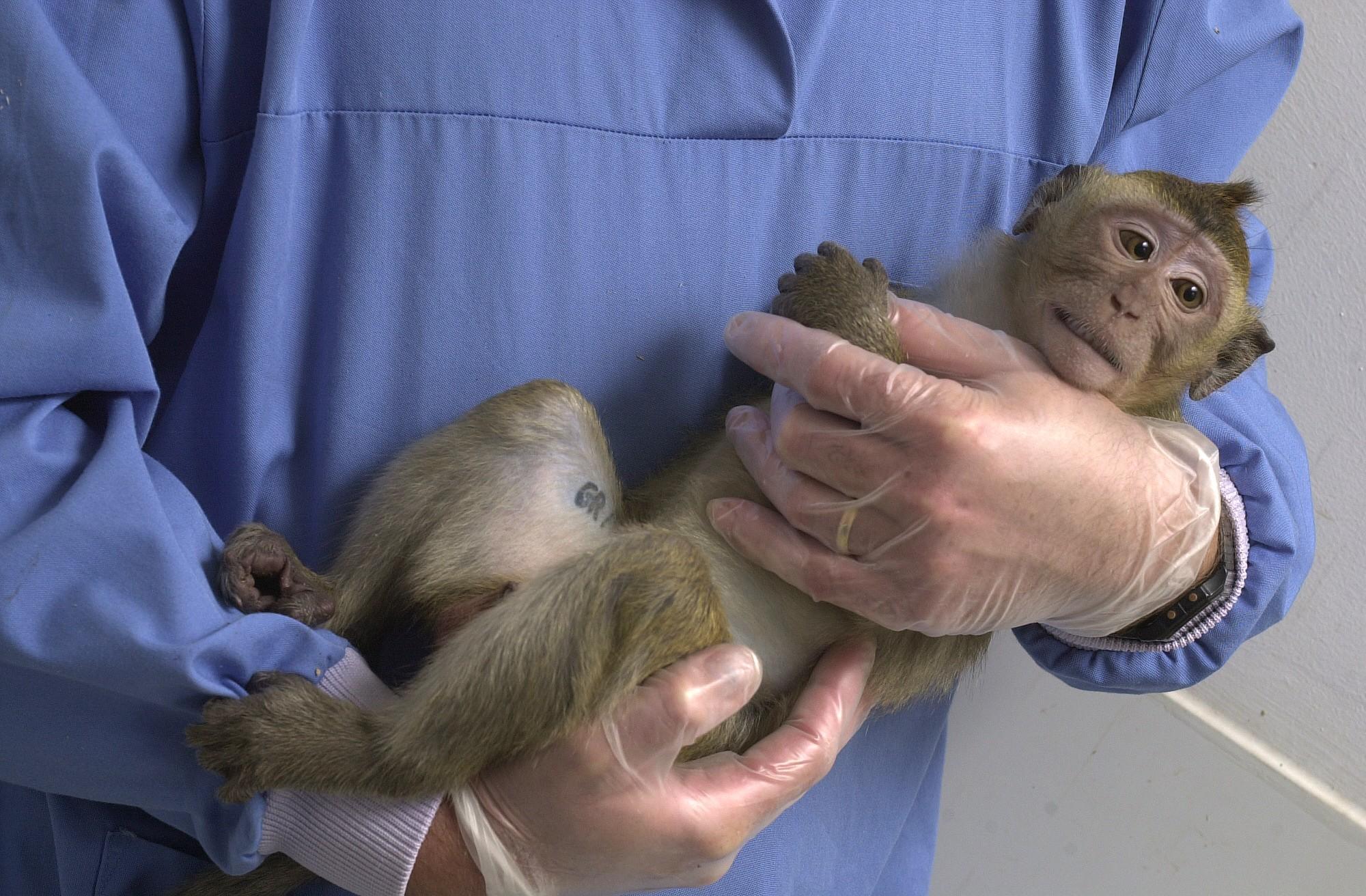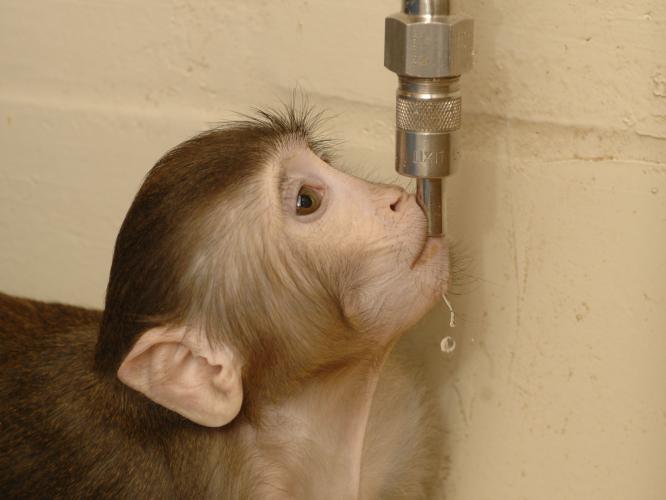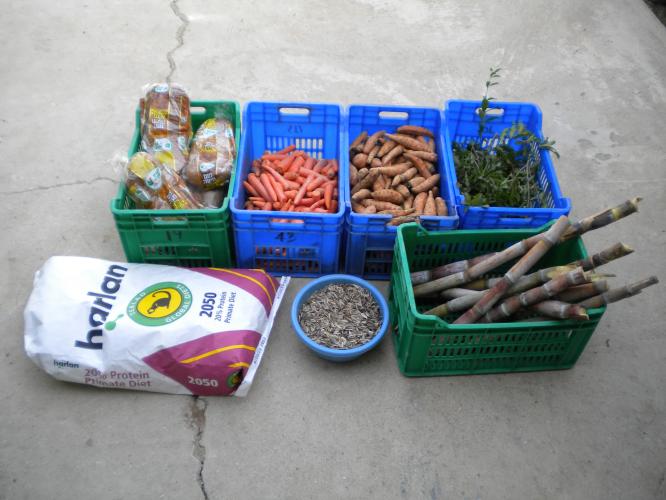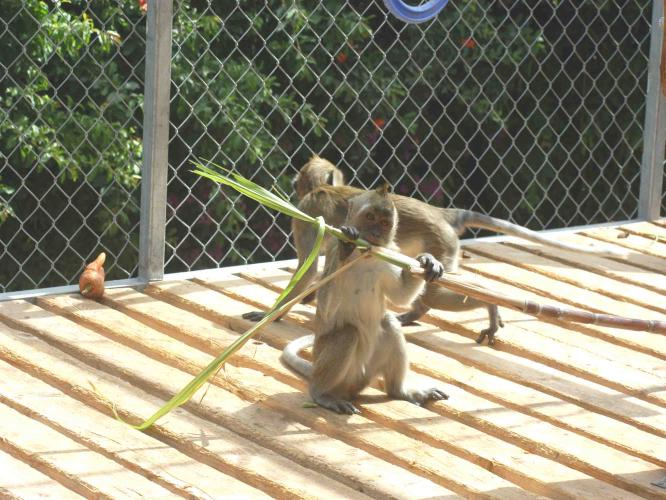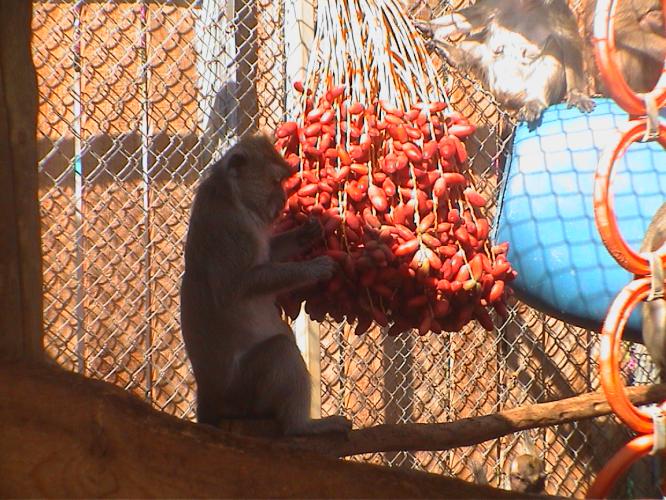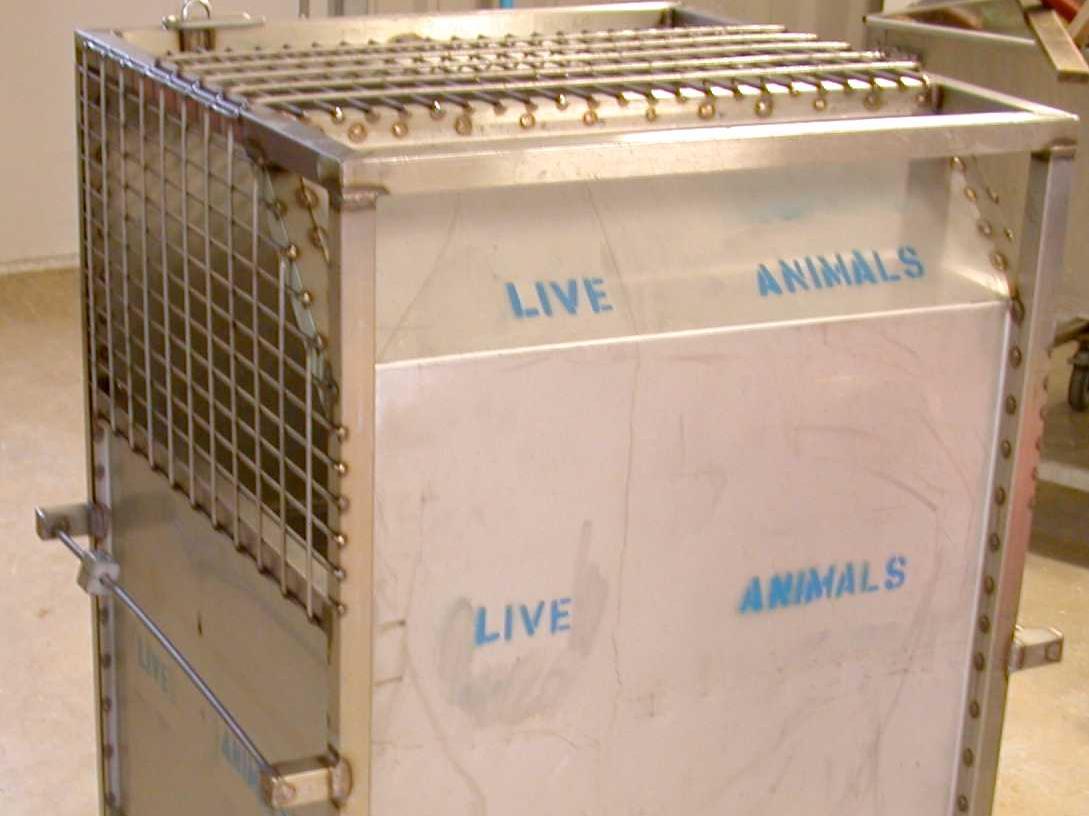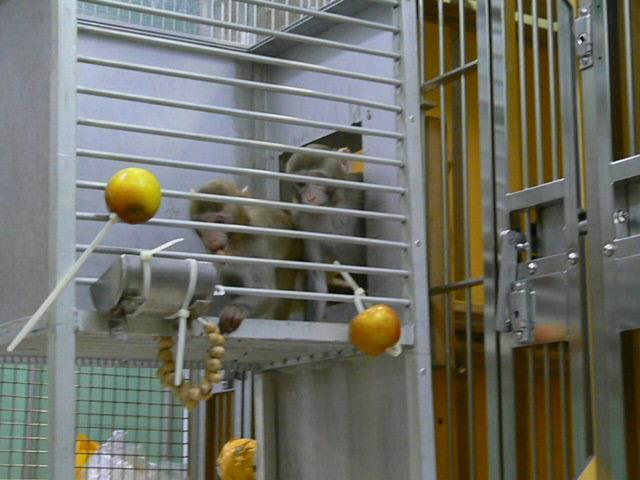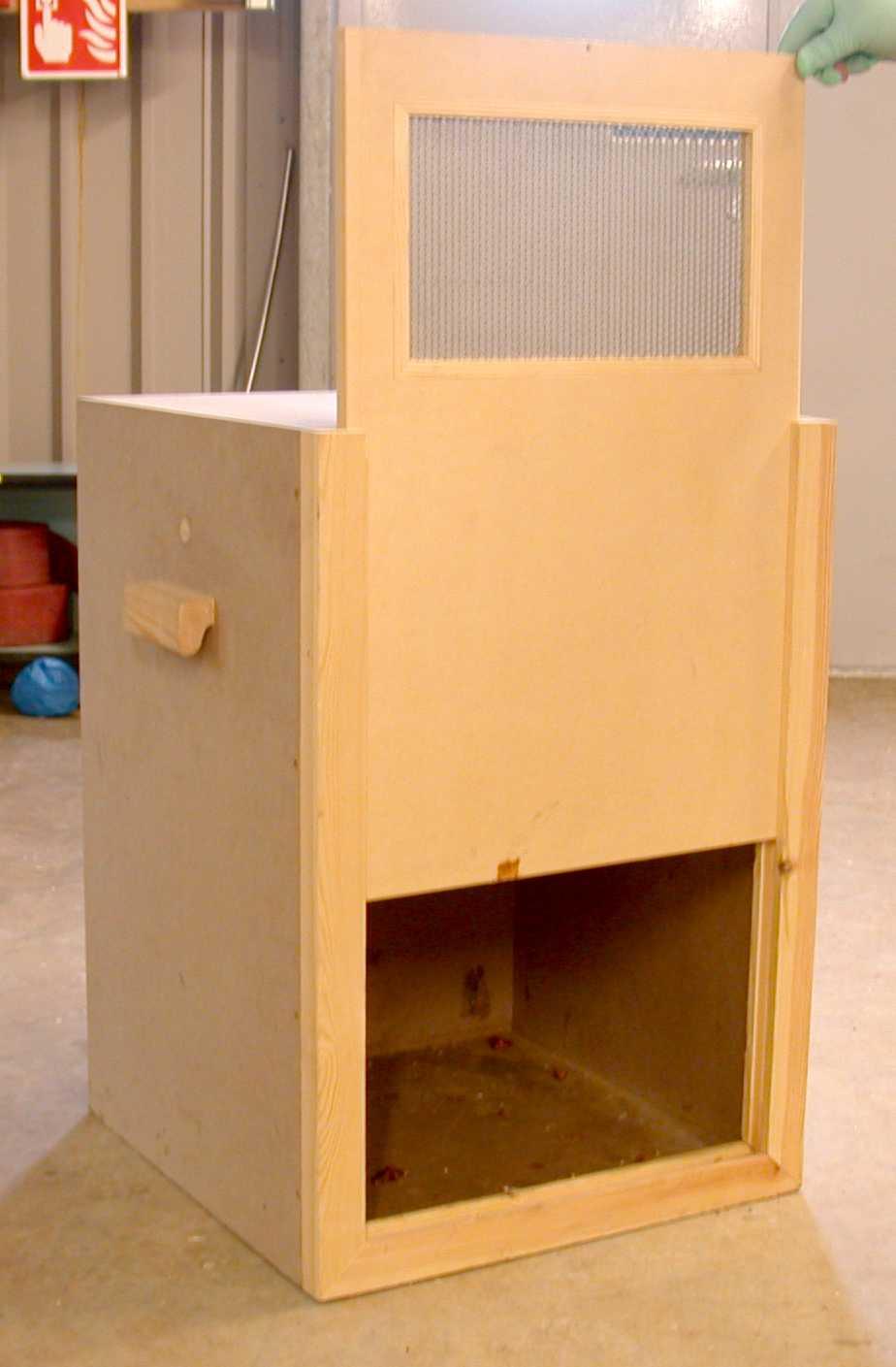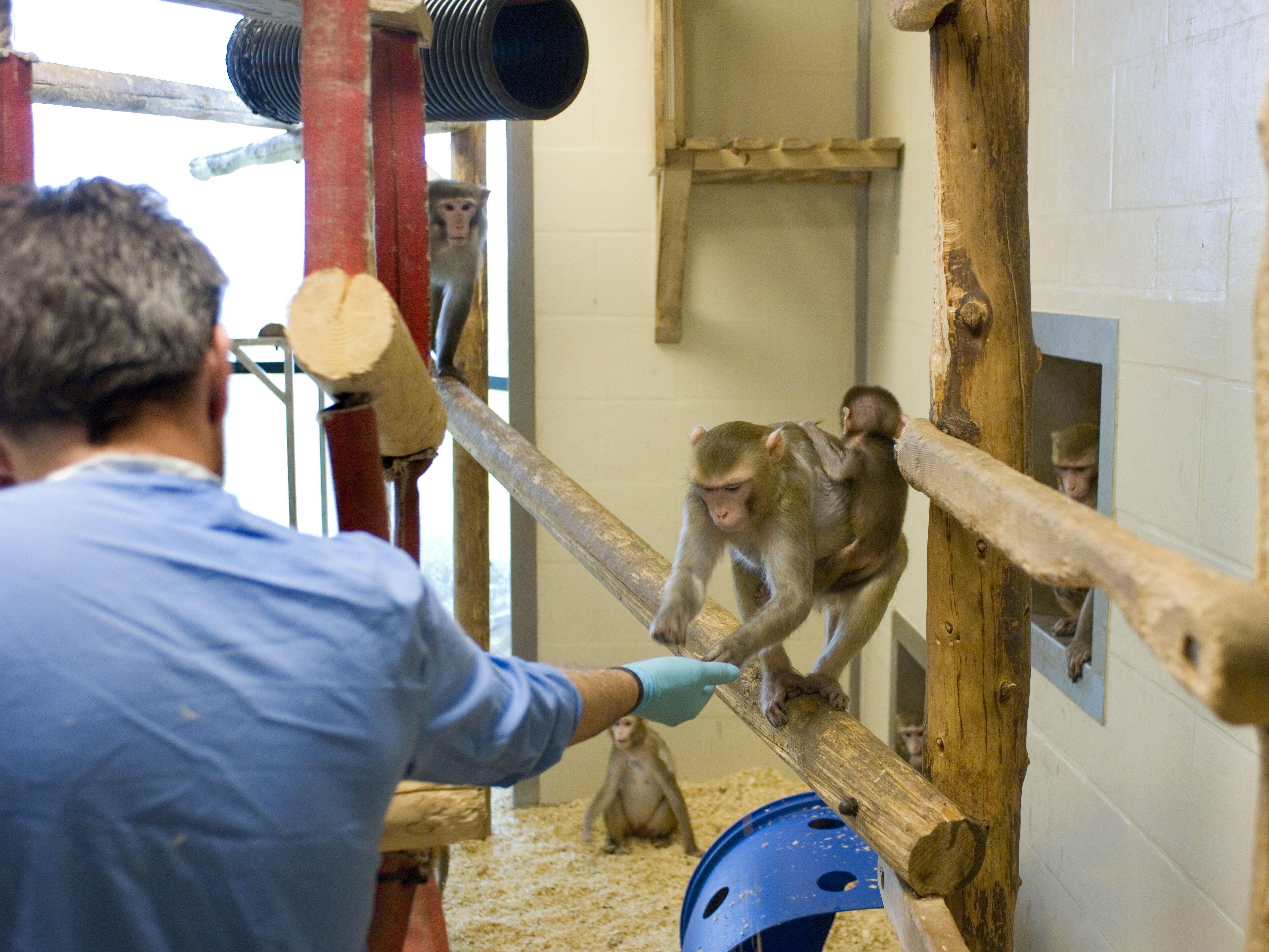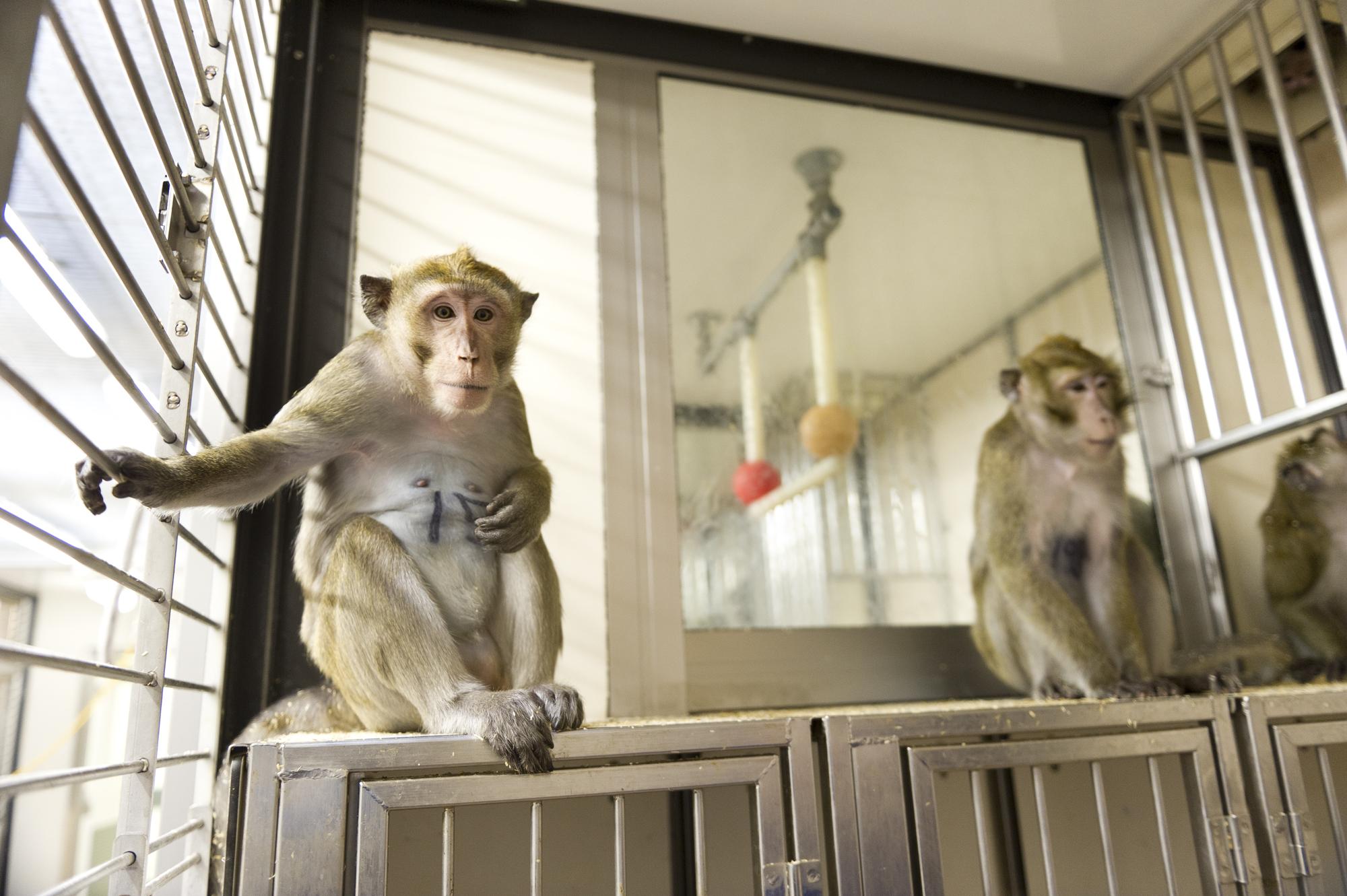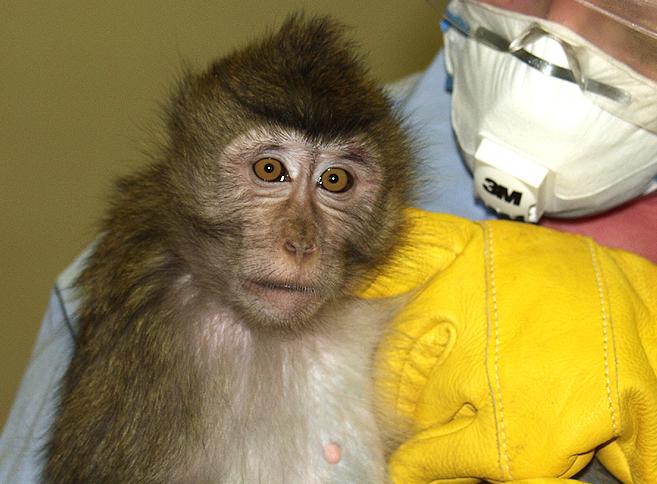Habituating the animals to humans, and training using positive reinforcement techniques, are important means of ensuring husbandry and other procedures can be conducted with minimal stress for both the animal and handler.
Many facilities that have supplied video for this website use macaques of defined, high health status (e.g. free of Macacine herpesvirus) [1]. Additional precautions include a high level of biosecurity and staff training, enabling staff members to work closely with the animals with minimum PPE whilst ensuring appropriate health and safety.
Recognition of individual macaques by staff is essential for good husbandry practice. It:
- Enhances staff understanding of individual animal’s personalities and needs.
- Develops bonds between staff and animals.
- Facilitates rapid detection of changes in behaviour or appearance due to injury or illness.
- Allows non-invasive, observational monitoring of animals.
- Increases speed and ease of animal handling.
-
 An infant rhesus macaque retrieving food from a technicians closed hand
An infant rhesus macaque retrieving food from a technicians closed hand
Identification methods
Ideally, non-invasive methods of identification should be used, particularly for pre-weaned animals, or else a combination of highly visible temporary identification with microchipping [2,3]. Non-invasive methods include natural appearance (see below), collars, with or without tags, dye marking of hair and hair clipping.
In some countries, permanent identification of individuals before weaning is a legal requirement [4,5]. This is usually accomplished by invasive means such as microchipping or tattooing. Ear notching and other forms of mutilation should never be used.
Always consider whether tattooing is really necessary, particularly when the breeder has already tattooed the animal. If tattooing is an essential prerequisite of a study, ask the breeder/supplier to microchip instead to avoid tattooing twice. If no other method will suffice, then the tattooing method that causes the least distress should be used. The tattoo should be as small as possible; it needs to be readable from a distance, but does not need to cover the animal’s chest or inside leg. Never tattoo the face, since this may disturb facial communication signals
Animals should be sedated for tattooing and local or topical anaesthesia used. For some individuals, general anaesthesia may be necessary – this should be judged on a case-by-case basis. Alternatively, the animal may be tattooed when anaesthetised for another purpose. Analgesia (NSAIDs) may be given before or after tattooing.
-
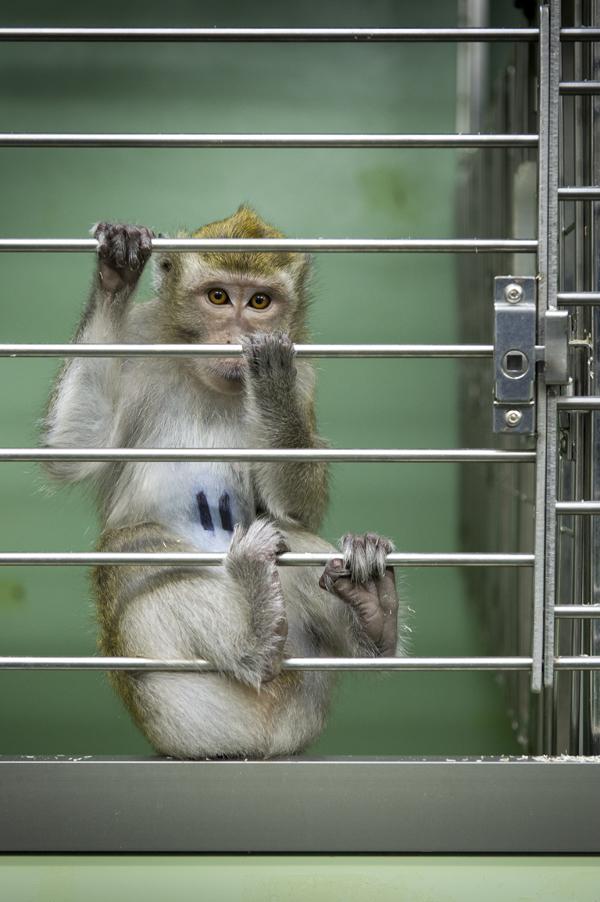 Dye mark identification
Dye mark identification -
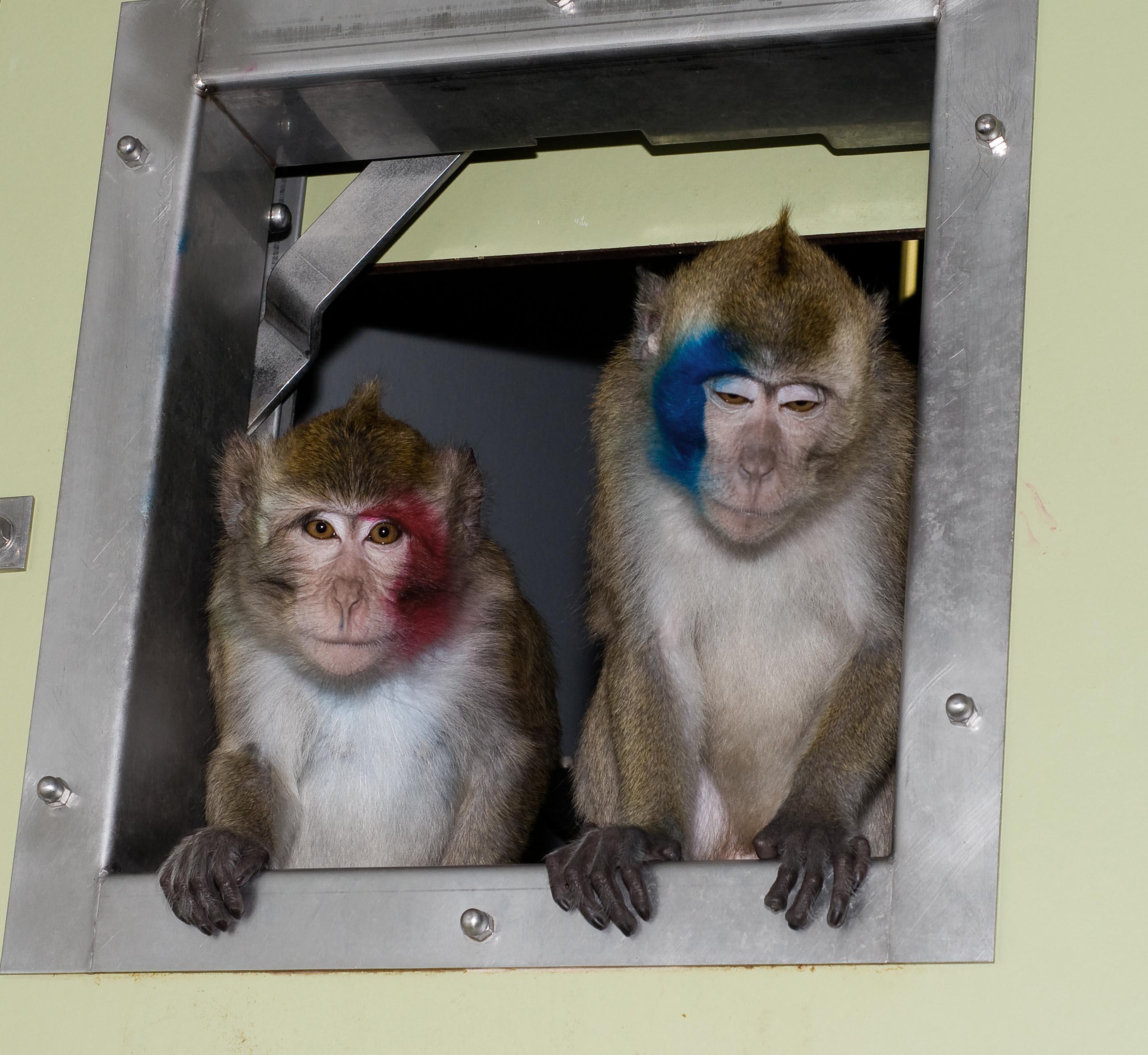 Face dye
Face dye
Advantages and disadvantages of identification methods
Non-invasive methods
Natural appearance
-
Comments: Variations in body size, fur colour or pattern, scars or other physical traits can be permanently recorded by photographs, drawings or written description.
-
Advantages: Quick and cost free, no effect on the animal.
-
Disadvantages: Difficult in large groups, particularly for small species; not suitable for good laboratory practice (GLP) studies.
Collar with/without tag
-
Comments: A potentially permanent unique identifier (e.g. name and number) included within a properly fitted collar and tag, which can be colour-coded for different sexes or individuals. Collars of any type should be inspected and cleaned regularly (e.g. during weighing or when catching animals for enclosure change) to ensure that they do not wear or cut into the skin.
-
Advantages: Little effect on the animal; quick and easy once staff know their animals.
-
Disadvantages: Some animals grow quickly and outgrow the collar; it may get caught in cage structures, or break and get lost; tags can become greasy and difficult to read.
Dye marking of hair
-
Comments: Non-toxic dyes such as permanent hair dye for human use are a useful minimally invasive short-term method to mark animals (e.g. on the top of the head or on the back). They have been used to mark the fur of macaques with no apparent effect on the animals’ communication.
-
Advantages: Minimally invasive.
-
Disadvantages: Most dyes last less than one month and animals have to be captured for re-application for longer-term marking. Dyes may cause allergies in some animals.
Hair clipping
-
Comments: Suitable for temporary marking; clipping of the tail fur of common marmosets or head fur in macaques can last up to four months before re-clipping is necessary. Curved scissors should be used rather than clippers because they are quieter and less likely to cut the skin.
-
Advantages: Minimally invasive, can be used on infant skin.
-
Disadvantages: Marks may disappear if the animal suffers from alopecia or hair plucking.
Invasive methods
Microchip
-
Comments: A unique permanent identifier that enables tracking of movement of animals between establishments or throughout any experimental period.
-
Advantages: Provides permanent identification; can also be used to record weight and temperature without further handling. Good for online recording of data.
-
Disadvantages: Gives no external indication of the animal’s identity so may be unsuitable for some applications. Need to be very close to the animal to read the microchip, which may require capture which can be stressful. Potentially provides a site for infection. Chips providing additional data may be large; chips may migrate, although modern chips carry a spur that makes this less likely. For refinement of the method, see Jennings et al. [2].
Tattoo
-
Comments: A permanent method although ink may diffuse over time and render the tattoo unreadable.
-
Advantages: More permanent than non-invasive methods and usually easy to read.
-
Disadvantages: Can be painful and distressing to the animal depending on how, when and where the tattoo is applied. Fur may obscure the tattoo, or it may be difficult to read on pigmented skin. Requires considerable technical expertise.
Natural appearance
Distinguishing features of a macaque’s appearance that can be used for individual identification.
-
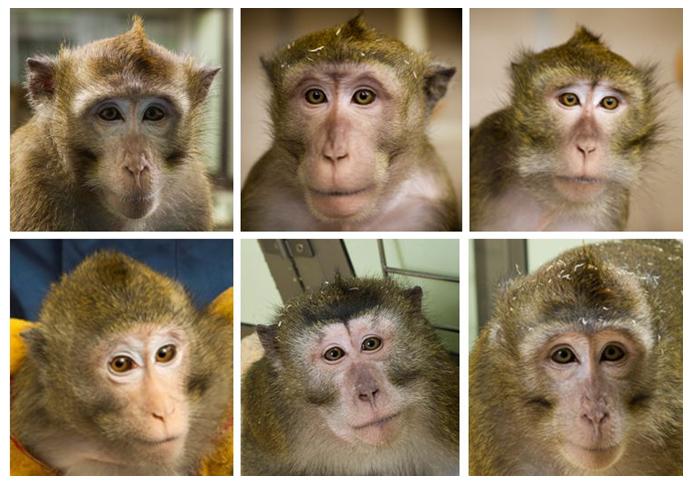 Images of cynomolgus macaques highlighting identification features.
Images of cynomolgus macaques highlighting identification features.
Face
- Head shape, length and width
- Skin colour (skin reddens during the mating season) and markings (white and dark spots/patches)
- Shape of crest of head, including pattern of hair
- Hairline around face
- Hair colour
- Brow shape and prominence
- Eye shape and colour
- Whiskers
- Ear shape including tears and nicks from fights
- Muzzle shape, length and width
- Nostril shape
- Scars
Body
- Size
- Tail length
- Hair colour and patterns
- Scars
- Gait (e.g. limp due to injury; older animals typically have impaired mobility)
- Behavioural traits (macaques have individual behavioural repertoires influenced by genetic predisposition, age, sex, reproductive status, social and physical environment)
- Social companions (female macaques remain in the natal group; therefore females spend the majority of their time in the presence of female kin)
-
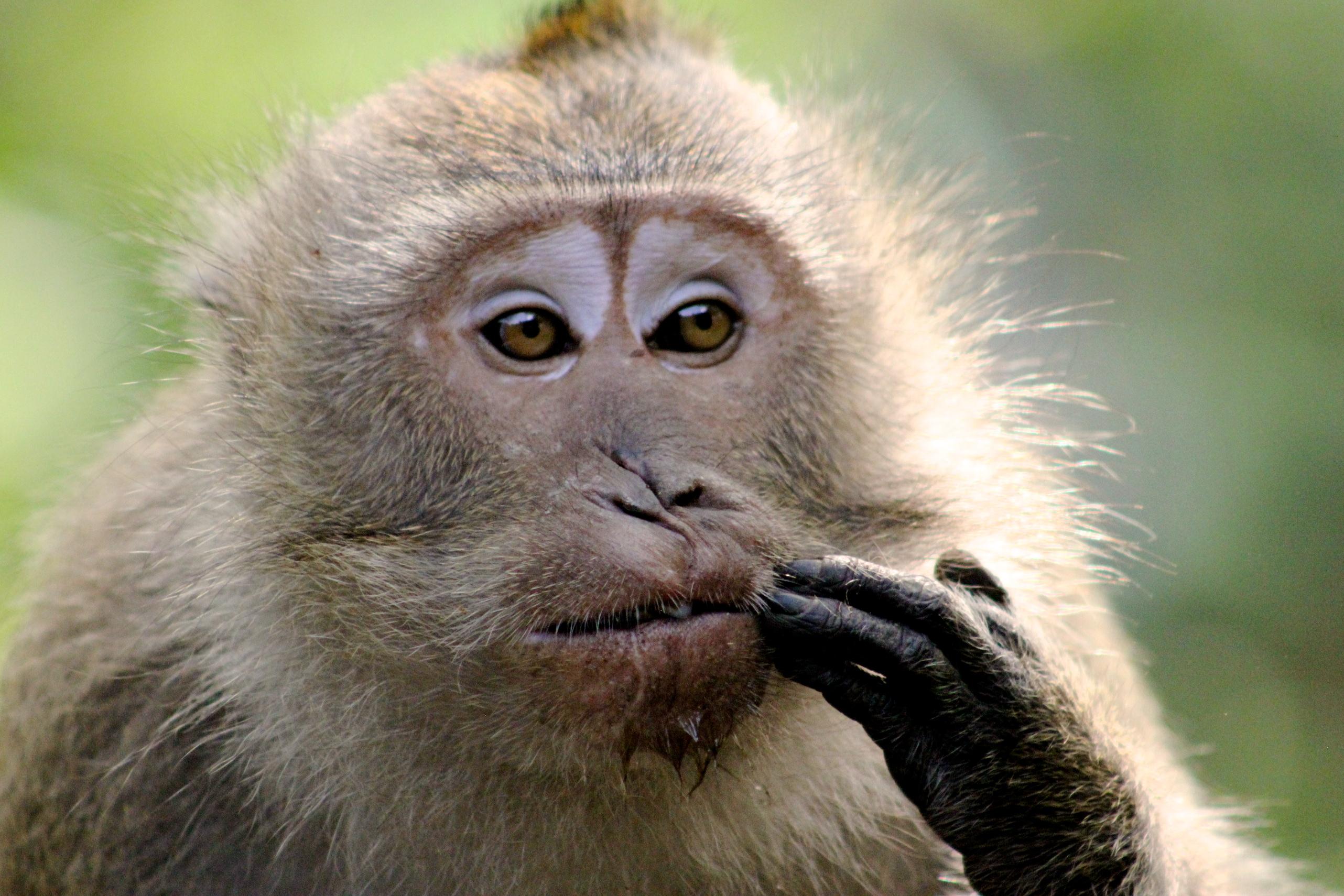 Scar identification (Image: Wendy Gomez)
Scar identification (Image: Wendy Gomez)
Refinement of handling practices is key for reducing stress during handling [2].
- Use purpose-bred animals of defined health status.
- Habituate the animals to humans early in life; this will facilitate handling and restraint, and may reduce the need for sedation (see Habituation and training).
- Ensure staff understand species-typical behaviour patterns and respond appropriately.
- Interaction begins on approach to the room or enclosure. Move and talk in a calm manner. Avoid direct eye contact. Ideally allow the animals to make the first approach; this will reduce fear and increase confidence in the animals.
- Minimise the number of times the animals need to be handled by developing protocols that allow performance of a number of procedures.
In the image above, you can see a technician cradling the animal. Talking softly also provides some comfort during handling. One arm supports the animal’s weight and the other safely immobilises the animal, holding it close to the body. This macaque is habituated to human contact and remains calm enough to be handled with light gloves. The tense mouth indicates some tension, so handling time is minimised.
Cleaning procedures can be an acutely stressful experience for the animals, leading to increased heart rate [28] and stress-related behaviour [42,43].
Ideally, cleaning duties should be carried out in a way that minimises the impact on the animals, even if this is at the cost of working efficiency [31]. Cleaners should also interact with the macaques in positive ways, so that they are not just associated with an unpleasant event.
- Excessive cleaning can cause stress and will not provide a health benefit. In healthy colonies, it should not be necessary to clean and sterilise cages areas daily.
- Uneaten food and excreta needs to be removed regularly. Wet and soiled areas of substrate (e.g. soft wood shavings, wood wool, straw) can be spot cleaned daily. The entire substrate can be changed on a weekly or fortnightly basis, depending on the number of animals within the enclosure.
- Substrate not only benefits animal welfare, but can also reduce financial costs, water usage and staff cleaning time [44]. Use of removable drain baskets (examples below) will avoids the substrate blocking drains.
- Enclosures and environmental enrichment items should be cleaned thoroughly every one to two months using hot water with non-toxic detergent, followed by a clean water rinse. Macaques should be removed from the enclosure before wet cleaning with hoses.
In the outdoor enclosure example below the slatted base allows faecal waste to be cleaned from under the enclosure with limited disruption to the animals.
-
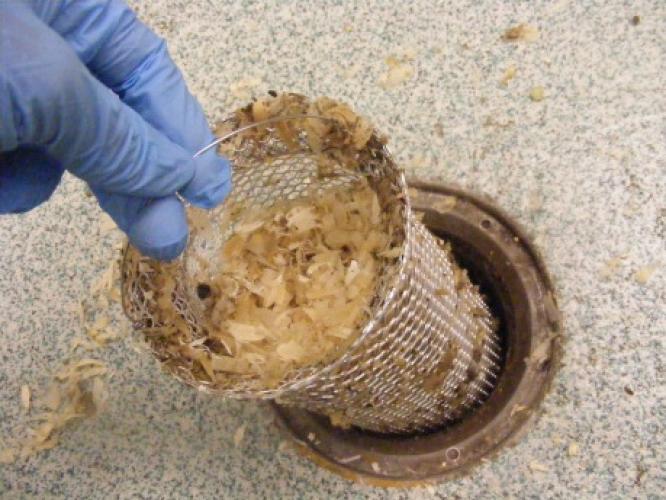 Drain basket 3
Drain basket 3 -
 Drain basket 2
Drain basket 2 -
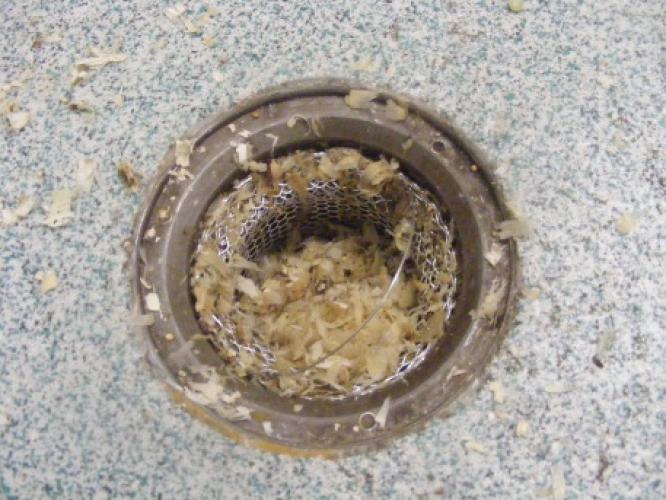 Drain basket 1
Drain basket 1 -
A semi-outdoor enclosure is enriched with brightly coloured environmental enrichment items
References
- Bayne K (2002). Development of the human-research animal bond and its impact on animal well-being. ILAR Journal 43(1): 4-9. https://doi.org/10.1093/ilar.43.1.4
- Jennings M et al. (2009). Refinements in husbandry, care and common procedures for non-human primates. Laboratory Animals 43(1_suppl): 1-47. https://doi.org/10.1258/la.2008.007143
- Rennie AE and Buchanan-Smith HM (2006). Refinement of the use of non-human primates in scientific research. Part ii: Housing, husbandry and acquisition. Animal Welfare. https://www.researchgate.net/publication/228670741
- Home Office. (2014). Guidance on the operation of the animals (scientific procedures) act 1986 (https://www.gov.uk/guidance/guidance-on-the-operation-of-the-animals-scientific-procedures-act-1986)
- European Union (2010). Directive 2010/63/EU on the protection of animals used for scientific purposes. Official Journal of the European Union 276: 33–79. eur-lex.europa.eu/eli/dir/2010/63/oj
- Suomi SJ et al. (1989). Pituitary--adrenal response to capture in cayo santiago--derived group m rhesus monkeys. Puerto Rico health sciences journal 8(1): 171-6.
- Reinhardt V (1991). Impact of venipuncture on physiological research conducted in conscious macaques. Journal of Experimental Animal Science 34(5-6): 212-7.
- Brockway BP and Hassler CR (1993). Application of radio telemetry to cardiovascular measurements in pharmacology and toxicology. In: New technologies and concepts for reducing drug toxicity (Eds. Salem H and Baskin SI) (pp. 109-32). CRC Press.
- Reinhardt V et al. (1995). Restraint methods of laboratory non-human primates: A critical review. Animal Welfare 4(3): 221-38.
- Honess PE and Marin CM (2006). Behavioural and physiological aspects of stress and aggression in nonhuman primates. Neuroscience & Biobehavioral Reviews 30(3): 390-412. https://doi.org/10.1016/j.neubiorev.2005.04.003
- Reinhardt V et al. (1990). Cortisol response of female rhesus monkeys to venipuncture in homecage versus venipuncture in restraint apparatus. Journal of Medical Primatology 19(6): 601-6. https://doi.org/10.1111/j.1600-0684.1990.tb00467.x
- Reinhardt V (2003). Working with rather than against macaques during blood collection. Journal of Applied Animal Welfare Science 6(3): 189-97. https://doi.org/10.1207/S15327604JAWS0603_04
- Luttrell L et al. (1994). Training a large troop of rhesus macaques to co-operate during catching: Analysis of the time investment. Animal Welfare 3(2): 135-40.
- Reinhardt V (1997). Training nonhuman primates to cooperate during handling procedures: A review. Animal Technology 48(2): 55-73.
- McMillan JL et al. (2014). Refining the pole-and-collar method of restraint: Emphasizing the use of positive training techniques with rhesus macaques (macaca mulatta). JAALAS 53(1): 61-8.
- Sainsbury AW et al. (1989). Restraint and anaesthesia of primates. Vet Rec 125(26-27): 23-30
- Klein HJ and Murray KA (1995). Medical management, part c: Restraint. In: Nonhuman primates in biomedical research (Eds. Bennett BT, Abee CR, and Henrickson R) (pp. 286-97). Academic Press.
- Norman RL and Smith CJ (1992). Restraint inhibits luteinizing hormone and testosterone secretion in intact male rhesus macaques: Effects of concurrent naloxone administration. Neuroendocrinology 55(4): 405-15. https://doi.org/10.1159/000126151
- Norman RL et al. (1994). Restraint inhibits luteinizing hormone secretion in the follicular phase of the menstrual cycle in rhesus macaques1. Biology of Reproduction 50(1): 16-26. https://doi.org/10.1095/biolreprod50.1.16
- Morton WR et al. (1987). Alternatives to chronic restraint of nonhuman primates. J Am Vet Med Assoc 191(10): 1282-6.
- Scott L et al. (2003). Training nonhuman primates to cooperate with scientific procedures in applied biomedical research. Journal of Applied Animal Welfare Science 6(3): 199-207. https://doi.org/10.1207/S15327604JAWS0603_05
- Fairhall SJ et al. (2006). A non-invasive method for studying an index of pupil diameter and visual performance in the rhesus monkey. Journal of Medical Primatology 35(2): 67-77. https://doi.org/10.1111/j.1600-0684.2005.00135.x
- Bliss-Moreau E et al. (2013). Efficient cooperative restraint training with rhesus macaques. Journal of Applied Animal Welfare Science 16(2): 98-117. https://doi.org/10.1080/10888705.2013.768897
- Gunnar M et al. (1980). The role of peers in modifying behavioral distress and pituitary-adrenal response to a novel environment in year-old rhesus monkeys. Physiology & Behavior 25(5): 795-8. https://doi.org/10.1016/0031-9384(80)90387-X
- Coelho AM et al. (1991). Assessing the effects of social environment on blood pressure and heart rates of baboons. American Journal of Primatology 23(4): 257-67. https://doi.org/10.1002/ajp.1350230406
- Coe CL et al. (1982). Hormonal responses accompanying fear and agitation in the squirrel monkey. Physiology & Behavior 29(6): 1051-7. https://doi.org/10.1016/0031-9384(82)90297-9
- Gonzales CA et al. (1982). Cortisol responses under different housing conditions in female squirrel monkeys. Psychoneuroendocrinology 7(2-3): 209-16. https://doi.org/10.1016/0306-4530(82)90014-2
- Hennessy M (1984). Presence of companion moderates arousal of monkeys with restricted social experience. Physiology & Behavior 33(5): 693-8. https://doi.org/10.1016/0031-9384(84)90033-7
- Tsuji Y (2010). Regional, temporal, and interindividual variation in the feeding ecology of japanese macaques. In: The japanese macaques. Primatology monographs (Eds. Nakagawa N, Nakamichi M, and Sugiura H) (Vol. 0, pp. 99-127). Springer. https://doi.org/10.1007/978-4-431-53886-8_5
- Majolo B et al. (2013). The effect of climatic factors on the activity budgets of barbary macaques (macaca sylvanus). International Journal of Primatology 34(3): 500-14. https://doi.org/10.1007/s10764-013-9678-8
- Wolfensohn S and Honess P (2005). Handbook of primate husbandry and welfare 1 ed. Wiley-Blackwell.
- Krishnamurthy R (1994). Vocalizations of captive françois’ langurs linked to stereotypy and possible stress. Folia Primatologica 63(2): 91-5. https://doi.org/10.1159/000156798
- Bloomsmith MA and Lambeth SP (1995). Effects of predictable versus unpredictable feeding schedules on chimpanzee behavior. Applied Animal Behaviour Science 44(1): 65-74. https://doi.org/10.1016/0168-1591(95)00570-I
- Carlstead K (1996). Effects of captivity on the behavior of wild mammals. In: Wild mammals in captivity: Principles and techniques (Eds. Carlstead K, Kleiman DG, Allen ME, Thompson KV, Lumpkin S, and Harris H) (pp. 317-33). University of Chicago Press
- Bassett L (2003). Effects of predictability of feeding routines on the behaviour and welfare of captive primates. In. Stirling.
- Gore MA (1993). Effects of food distribution on foraging competition in rhesus monkeys, macaca mulatta, and hamadryas baboons, papio hamadryas. Animal Behaviour 45(4): 773-86. https://doi.org/10.1006/anbe.1993.1091
- National Research C (2003). Occupational health and safety in the care and use of nonhuman primates. The National Academies Press.
- Waitt C and Buchanan-Smith HM (2001). What time is feeding? Applied Animal Behaviour Science 75(1): 75-85. https://doi.org/10.1016/S0168-1591(01)00174-5
- Bassett L and Buchanan-Smith HM (2007). Effects of predictability on the welfare of captive animals. Applied Animal Behaviour Science 102(3-4): 223-45. https://doi.org/10.1016/j.applanim.2006.05.029
- Gottlieb DH et al. (2013). Risk factors for stereotypic behavior and self-biting in rhesus macaques (macaca mulatta): Animal's history, current environment, and personality. American Journal of Primatology 75(10): 995-1008. https://doi.org/10.1002/ajp.22161
- Line SW et al. (1990). Increased cage size does not alter heart rate or behavior in female rhesus monkeys. American Journal of Primatology 20(2): 107-13. https://doi.org/10.1002/ajp.1350200205
- Lambeth SP et al. (1997). Effects of human activity on chimpanzee wounding. Zoo Biology 16(4): 327-33. https://doi.org/10.1002/(SICI)1098-2361(1997)16:4<327::AID-ZOO4>3.0.CO;2-C
- Morgan KN and Tromborg CT (2007). Sources of stress in captivity. Applied Animal Behaviour Science 102(3-4): 262-302. https://doi.org/10.1016/j.applanim.2006.05.032
- Doane CJ et al. (2013). Dry bedding provides cost-effective enrichment for group-housed rhesus macaques (macaca mulatta). JAALAS 52(3): 247-52.
- Wolfensohn SE (1997). Brief review of scientific studies of the welfare implications of transporting primates. Laboratory Animals 31(4): 303-5. https://doi.org/10.1258/002367797780596167
- Honess PE et al. (2004). A study of behavioural responses of non-human primates to air transport and re-housing. Laboratory Animals 38(2): 119-32. https://doi.org/10.1258/002367704322968795
- Line SW et al. (1990). Increased cage size does not alter heart rate or behavior in female rhesus monkeys. American Journal of Primatology 20(2): 107-13. https://doi.org/10.1002/ajp.1350200205
- Swallow J et al. (2005). Guidance on the transport of laboratory animals. Laboratory Animals 39(1): 1-39. https://doi.org/10.1258/0023677052886493
- Reinhardt V (1992a). Difficulty in training juvenile rhesus macaques to actively cooperate during venipuncture in the homecage. Laboratory Primate Newsletter 31: 1-2.
- Reinhardt V (1992b). Transport-cage training of caged rhesus macaques. Animal Technology 43: 57-61.
- Waitt C et al. (2002). The effects of caretaker-primate relationships on primates in the laboratory. Journal of Applied Animal Welfare Science 5(4): 309-19. https://doi.org/10.1207/S15327604JAWS0504_05
- Prescott MJ and Buchanan-Smith HM (2003). Training nonhuman primates using positive reinforcement techniques. Journal of Applied Animal Welfare Science 6(3): 157-61. https://doi.org/10.1207/S15327604JAWS0603_01
- Prescott MJ and Buchanan-Smith HM (2007). Training laboratory-housed non-human primates, part 1: A uk survey. Animal Welfare 16: 21-36.
- Prescott MJ et al. (2005). Social interaction with non-averse group-mates modifies a learned food aversion in single- and mixed-species groups of tamarins (saguinus fuscicollis ands. Labiatus). American Journal of Primatology 65(4): 313-26. https://doi.org/10.1002/ajp.20118
- Schapiro SJ et al. (2005). Training nonhuman primates to perform behaviors useful in biomedical research. Lab Animal 34(5): 37-42. https://doi.org/10.1038/laban0505-37
- Coleman K et al. (2005). Temperament correlates with training success in adult rhesus macaques. American Journal of Primatology 65(1): 63-71. https://doi.org/10.1002/ajp.20097
- Coleman K (2012). Individual differences in temperament and behavioral management practices for nonhuman primates. Applied Animal Behaviour Science 137(3-4): 106-13. https://doi.org/10.1016/j.applanim.2011.08.002
- Bayne KA et al. (1993). The effects of food treat provisioning and human interaction on the behavioral wel1-being of rhesus monkeys (macaca mulatta). Contemporary topics in laboratory animal science 33(2): 6-9.
- Coleman K et al. (2008). Training rhesus macaques for venipuncture using positive reinforcement techniques: A comparison with chimpanzees. Journal of the American Association for Laboratory Animal Science : JAALAS 47(1): 37-41.
- Fernström AL et al. (2009). Positive reinforcement training in rhesus macaques-training progress as a result of training frequency. American Journal of Primatology 71(5): 373-9. https://doi.org/10.1002/ajp.20659
- Laule G (1992). Training laboratory animals. In: . Ufaw handbook on the care and management of laboratory animals, vol. 1: Terrestrial vertebrates (Ed., Poole T) (7 ed., pp. 21-7). Blackwell Science.
- Schapiro SJ et al. (2005). Training nonhuman primates to perform behaviors useful in biomedical research. Lab Animal 34(5): 37-42. https://doi.org/10.1038/laban0505-37
- McMillan JL et al. (2014). Refining the pole-and-collar method of restraint: Emphasizing the use of positive training techniques with rhesus macaques (macaca mulatta). JAALAS 53(1): 61-8.
- Blanchard JL and Russell-Lodrigue KE (2012). Biosafety in laboratories using nonhuman primates. In: Nonhuman primates in biomedical research (Eds. Abee CR, Mansfield K, Tardif S, and Morris T) (2 ed., Vol. 1, pp. 437-92). Academic Press. https://doi.org/10.1016/B978-0-12-381365-7.00018-2
- Health and Safety Executive. (2011). Control of laboratory animal allergy.
- Health and Safety Executive. (1997). Working safely with research animals: Management of infection risks.
- Health and Safety Executive. (2005). Personal protective equipment at work.
- Advisory Committee on Dangerous Pathogens. (1998). Working safely with simians: Management of infection risks.
- Fontes B (2008). Institutional responsibilities in contamination control for research animals and in occupational health and safety for animal handlers. ILAR Journal 49(3): 326-37. https://doi.org/10.1093/ilar.49.3.326
- Health and Safety Executive. (2013). Control of substances hazardous to health.
- Advisory Committee on Dangerous Pathogens. (1995). Categorisation of biological agents according to hazard and categories of containment.
- National Research Council (2003). Occupational health and safety in the care and use of nonhuman primates. The National Academies Press.
- Wald PH and Stave GM (2003). Occupational medicine programs for animal research facilities. ILAR Journal 44(1): 57-71. https://doi.org/10.1093/ilar.44.1.57
- Health and Safety Executive. (2005). Personal protective equipment at work.



